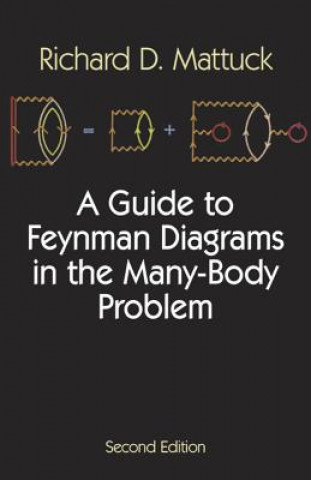
Livrare
Consilier de cumpărături





Nu se pretează? Nu contează! La noi puteți returna bunurile în 30 de zile
 Voucher cadou
orice valoare
Voucher cadou
orice valoare
Cu un voucher cadou nu veți da greș. În schimbul voucherului, destinatarul își poate alege orice din oferta noastră.
Guide to Feynman Diagrams in the Many-body Problem
 engleză
engleză
 93 b
93 b
30 de zile pentru retur bunuri
Ar putea de asemenea, să te intereseze


Preface to second edition Preface to first edition. 0. The Many-Body Problem- for Everybody 0.0 What the many-body problem is about 0.1 Simple example of non-interacting fictitious bodies 0.2 Quasi particles and quasi horses 0.3 Collective excitations 1. "Feynman Diagrams, or how to Solve the Many-Body Problem by means of Pictures " 1.1 Propagators-the heroes of the many-body problem 1.2 Calculating propagators by Feynman diagrams: the drunken man propagator 1.3 Propagator for single electron moving through a metal 1.4 Single-particle propagator for system of many interacting particles 1.5 The two-particle propagator and the particle-hole propagator 1.6 The no-particle propagator ('vacuum amplitude') 2. Classical Quasi Particles and the Pinball Propagator 2.1 Physical picture of quasi particle 2.2 The classical quasi particle propagator 2.3 Calculation of the propagator by means of diagrams 3. Quantum Quasi Particles and the Quantum Pinball Propagator 3.1 The quantum mechanical propagator 3.2 The quantum pinball game 3.3 Disappearance of disagreeable divergences 3.4 Where the diagram expansion of the propagator really comes from 3.5 Energy and lifetime of an electron in an impure metal 4. Quasi Particles in Fermi Systems 4.1 Propagator method in many-body systems 4.2 Non-interacting Fermi system in external potential; particle-hole picture 4.3 A primer of occupation number formalism (second quantization) 4.4 Propagator for non-interacting Fermi system in external perturbing potential 4.5 Interacting Fermi system 4.6 The 'quasi-physical' nature of Feynman diagrams 4.7 Hartree and Hartree-Fock quasi particles 4.8 Hartree-Fock quasi particles in nuclear matter 4.9 "Quasi particles in the electron gas, and the random phase approximation " 5. Ground State Energy and the Vacuum Amplitude or 'No-particle Propagator' 5.1 Meaning of the vacuum amplitude. 5.2 The pinball machine vacuum amplitude 5.3 Quantum vacuum amplitude for one-particle system 5.4 Linked cluster theorem for one-particle system 5.5 Finding the ground state energy in one-particle system. 5.6 The many-body case 6. Bird's-Eye View of Diagram Methods in the Many-Body Problem 7. Occupation Number Formalism (Second Quantization) 7.1 The advantages of occupation number formalism 7.2 Many-body wave function in occupation number formalism 7.3 Operators in occupation number formalism 7.4 Hamiltonian and Schrödinger equation in occupation number formalism 7.5 Particle-hole formalism 7.6 Occupation number formalism based on single-particle position eigenstates 7.7 Bosons 8. More about Quasi Particles 8.1 Introduction 8.2 A soluble fermion system: the pure Hartree model 8.3 Crude calculation of quasi particle lifetime 8.4 General form of quasi particle propagator 9. The Single-Particle Propagator Re-visited 9.1 Second quantization and the propagator 9.2 Mathematical expression for the single-particle Green's function propagator. 9.3 Spectral density function 9.4 Derivation of the propagator expansion in the many-body case 9.5 Topology of diagrams 9.6 Diagram rules for single-particle propagator 9.7 "Modified propagator formalism using chemical potential, µ " 9.8 Beyond Hartree-Fock: the single pair-bubble approximation 10. "Dyson's Equation, Renormalization, RPA and Ladder Approximations " 10.1 General types of partial sums 10.2 Dyson's equation 10.3 Quasi particles in low-density Fermi system (ladder approximation) 10.4 Quasi particles in high-density electron gas (random phase approximation) 10.5 The general 'dressed' or 'effective' interaction 10.6 The scattering amplitude 10.7 Evaluation of the pair bubble; Friedel oscillations 11. Self-Consistent Renormalization and the Existence of the Fermi Surface 11.1 "Dressed particle and hole lines, or 'clothed skeletons' " 11.2 Existence of quasi particles when the perturbation expansion is valid 11.3 Existence of the Fermi surface in an interacting system. 11.4 Dressed vertices 12. Ground State Energy of Electron Gas and Nuclear Matter 12.1 Review 12.2 Diagrams for the ground state energy 12.3 Ground state energy of high-density electron gas: theory of Gell-Mann and Brueckner 12.4 Brief view of Brueckner theory of nuclear matter 13. Collective Excitations and the Two-Particle Propagator 13.1 Introduction 13.2 The two-particle Green's function propagator 13.3 Polarization ('density fluctuation') propagator 13.4 Retarded polarization propagator and linear response 13.5 The collective excitation propagator 13.6 Plasmons and quasi plasmons 13.7 Expressing the two-particle propagator in terms of the scattering amplitude 14. Fermi Systems at Finite Temperature 14.1 Generalization of the T = 0 case 14.2 Statistical mechanics in occupation number formalism 14.3 The finite temperature propagator 14.4 The finite temperature vacuum amplitude 14.5 The pair-bubble at finite temperature 15. Diagram Methods in Superconductivity 15.1 Introduction 15.2 Hamiltonian for coupled electron-phonon system. 15.3 Short review of BCS theory 15.4 Breakdown of the perturbation expansion in a superconductor 15.5 A brief look at Nambu formalism 15.6 Treatment of retardation effects by Nambu formalism 15.7 Transition temperature of a superconductor 16. Phonons From a Many-Body Viewpoint (Reprint) 17. Quantum Field Theory of Phase Transitions in Fermi Systems 17.1 Introduction 17.2 Qualitative theory of phase transitions 17.3 Anomalous propagators and the breakdown of the perturbation series in the condensed phase. 17.4 The generalized matrix propagator 17.5 Application to ferromagnetic phase in system with d-function interaction. 17.6 I Divergence of the two-particle propagator and scattering amplitude at the transition point 18. Feynman Diagrams in the Kondo Problem 18.1 Introduction 18.2 Second-order (Born) approximation. 18.3 Parquet approximation with bare propagators. 18.4 Self-consistently renormalized s-electrons r 18.5 Strong-coupling approximation with self-consistently renormalized pseudofermions and vertices. 19. The Renormalization Group 19.1 Introduction 19.2 Review of effective interaction in the high-density electron gas 19.3 Renormalization group for interaction propagators in the high-density electron gas. 19.4 Transforming from one transformed quantity to another: the functional equation of the renormaIization group 19.5 Lie equation for the renormalization group 19.6 Solution of the Lie equation Appendices A Finding fictitious particles with the canonical transformation. A. Dirac formalism B. "The time development operator, U(t) . " C. Finding the ground state energy from the vacuum amplitude. D. "The u(t) operator and its expansion, " E. Expansion of the single-particle propagator and vacuum amplitude F. Evaluating matrix elements by Wick's theorem. G. Derivation of the graphical expansion for propagator and vacuum H. The spectral density function I. How the id factor is used J. Electron propagator in normal electron-phonon system K. Spin wave functions. L. Sunmary of different kinds of propagators and their spectral representations and analytic properties. . M. The decoupled equations of motion for the Green's function expressed as a partial sum of Feyman diagrams N. The reduced graph expansion Answers to Exercises References Index
Informații despre carte
 engleză
engleză




 Cum să cumpăr
Cum să cumpăr

































